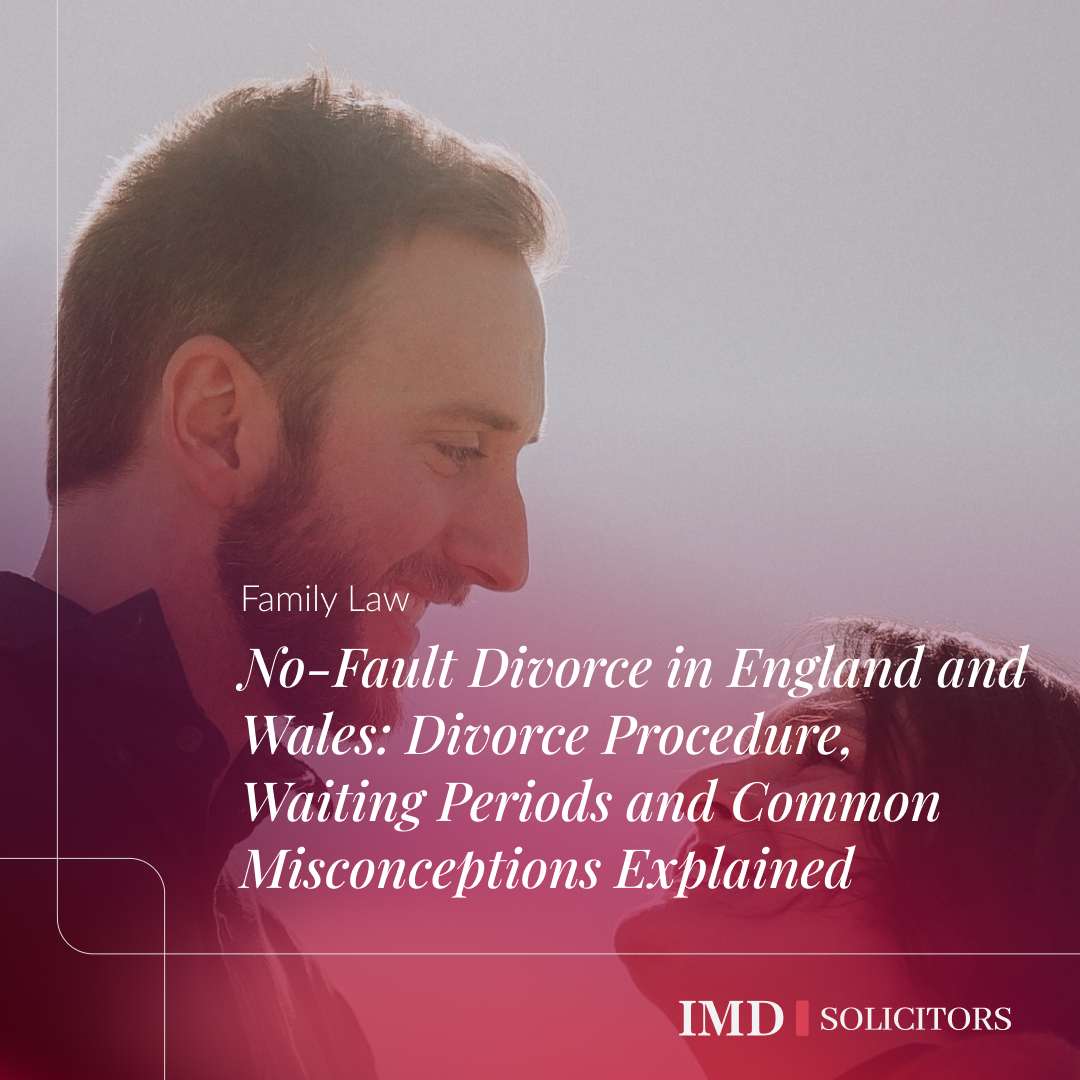No-Fault Divorce in England and Wales: Divorce Procedure, Waiting Periods and Common Misconceptions Explained

Speak to a member of our specialist international team of UK family lawyers today on 0330 107 0107.
Introduction
Since the introduction of no-fault divorce in England and Wales under the Divorce, Dissolution and Separation Act 2020, the process of divorce has undergone significant reform. The removal of the requirement to prove fault through grounds such as unreasonable behaviour, adultery, desertion, or lengthy separation has simplified the legal framework. Applicants are no longer required to assign blame, and couples are able to make a joint application for divorce if they wish.
However, while the reforms have reduced conflict and made divorce more accessible, a common misconception has developed. Many individuals assume that because fault is no longer required, the process is automatically quicker. In reality, court-imposed waiting periods remain a central part of the divorce procedure. This case study examines the legal procedure, highlights practical issues, and clarifies the current position to assist those considering divorce.
The Divorce Application and the First Waiting Period
The process begins with the submission of a divorce application, either individually or jointly. Once issued by the court and served upon the respondent, the law requires a minimum period of 20 weeks before the applicant can proceed further. This stage is often referred to as the “reflection” or “cooling-off” period.
The rationale behind this waiting period is to give both parties sufficient time to reflect on the decision and to consider reconciliation if appropriate. The court has made this stage mandatory, ensuring that divorces are not rushed through without due consideration.
For applicants, it is important to understand that this 20-week period cannot be shortened or waived, even where both parties are in agreement that the marriage has irretrievably broken down. This is a safeguard designed to protect both parties from hasty or impulsive decisions, and it reflects the seriousness of legally ending a marriage.
Conditional Order: The Second Stage
Once the 20-week period has lapsed, the applicant may apply for a conditional order, formerly known as a Decree Nisi. This order confirms that the court is satisfied with the legal basis of the divorce application and that the divorce may proceed to the next stage.
It is worth noting that the conditional order does not in itself end the marriage. Instead, it provides formal recognition that the divorce may be finalised at a later date. The court has replaced outdated terminology to simplify the language used in family proceedings, making the process more accessible to those without legal training.
The Six-Week Waiting Period and Final Order
Following the issuing of the conditional order, there is a further mandatory waiting period of six weeks before the applicant can apply for a final order, which was formerly known as a Decree Absolute. Only upon the granting of the final order is the marriage legally terminated.
This second waiting period exists for similar reasons to the first. It allows parties to reconsider their decision and ensures that finalisation does not occur without due opportunity for reflection.
In practice, once the application for the final order is submitted, courts usually process it swiftly. Many practitioners, including those at IMD Solicitors LLP, observe that final orders are often granted within 48 hours of application. However, once the final order has been issued, there is no mechanism for reversing the divorce. The marriage is legally at an end, and the only recourse for reconciliation would be remarriage.
Timescales in Practice
Taken together, the two waiting periods result in a minimum timescale of 26 weeks—approximately 6 months—for the conclusion of divorce proceedings. Although the application process itself is simpler, the statutory timeframes mean that divorce is not necessarily faster than before.
Additional delays can occur where the respondent does not engage with the process. If the respondent fails to acknowledge service, further steps such as applications for deemed service, bailiff service, or alternative service methods may be necessary. Each of these adds to the overall length and cost of the proceedings.
Practical Insights for Clients
- Expect a minimum of six months – The simplified procedure does not eliminate the waiting periods. Clients should plan for at least six months, and potentially longer if complications arise.
- Consider financial arrangements separately – While the divorce application progresses, parties must also address financial settlements and child arrangements if relevant. These matters are not automatically resolved through the divorce process and often require separate negotiation or court proceedings.
- Respond promptly – Cooperation between the applicant and respondent can avoid unnecessary delay. Prompt responses ensure that the process runs within the statutory timeframes.
- Final order implications – Clients should seek legal advice before applying for a final order if financial arrangements remain unresolved. Dissolving the marriage may affect pension rights, inheritance, and other entitlements, and it may be advisable to delay the final order until a financial settlement has been secured.
Conclusion
The introduction of no-fault divorce has marked a major development in family law by removing unnecessary conflict from proceedings. However, the waiting periods remain a central feature of the process, ensuring that divorce is approached with reflection and responsibility.
At IMD Solicitors LLP, we advise clients to approach divorce with a clear understanding of both the legal requirements and the practical implications. While the process is more straightforward than before, it is not automatically shorter, and planning for financial and child-related matters remains essential.
This article is for general information only and does not constitute legal or professional advice. Please note that the law may have changed since this article was published.



















